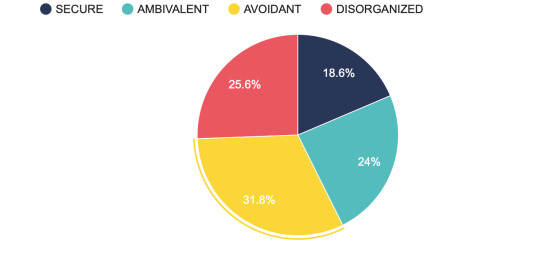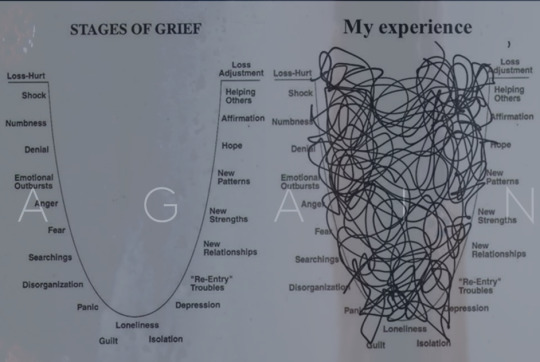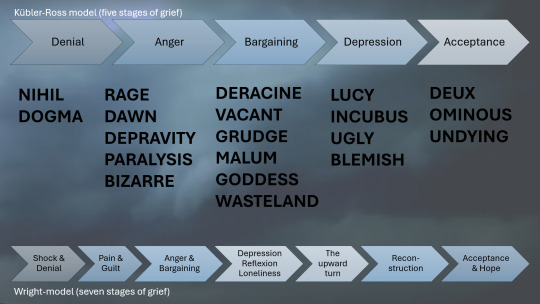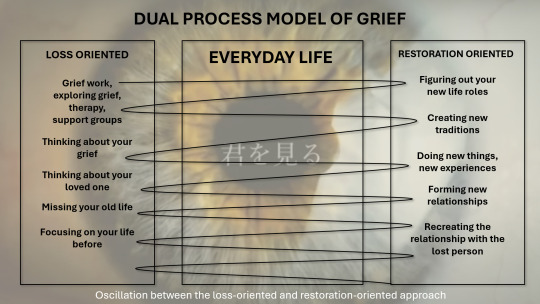#John Bowlby
Explore tagged Tumblr posts
Text
Here's a quiz you could take as your OC if you want

#polls#poll#psychology#bowlby#attachment#attachment styles#attachment types#ocs#oc#john bowlby#amy ainsworth
25 notes
·
View notes
Text

Thank you Anthony Dominick Benedetto. You’ve made our hearts sing with passion for a long, long time.
* * * *
“Life teaches you how to live it — if you live long enough.”
― Tony Bennett
+
“Feeling listened to and understood changes our physiology; being able to articulate a complex feeling, and having our feelings recognized, lights up our limbic brain and creates an “aha moment”. In contrast, being met by silence and incomprehension kills the spirit. Or, as John Bowlby so memorably put it: “What can not be spoken to the [m]other cannot be told to the self.””
— Bessel Van Der Kolk, “The Body Keeps the Score: Brain, Mind and Body in the Healing of Trauma
#Tony Bennett#quotes#R.I.P.#mother#listening#being understood#physiology#John Bowlby#Bessel Van Der Kolk#The Body Keeps the Score: Brain Mind and body in the Healing of Trauma
21 notes
·
View notes
Text
gotta say thanks to my psychology teacher, now that I've studied Bowlby I finally understand Will Graham's character
#hannibal nbc#will graham#nbc hannibal#hannibal#hannibal lecter#john bowlby#its so funny to study things like this#that#will graham core#burn the gays#murder husbands
3 notes
·
View notes
Text
Kolektif – Travma ve Kayıp (2024)
Bağlanma kuramının kurucusu John Bowlby, yaşamı boyunca görüşlerine karşı oluşan güçlü muhalefet nedeniyle istediği gibi yayın yapamadı. Robbie Duschinsky ve Kate White’ın titiz çalışmasıyla ortaya konan bu kitap, Wellcome Koleksiyonu’ndaki John Bowlby Arşivi’nden bazı tamamlanmış ve tamamlanmaya yakın çalışmaları gün ışığına çıkarıyor ve alana dair önemli bir ihtiyacı karşılıyor. Bu geniş…

View On WordPress
#2024#Özenç Ertan Öztekin#John Bowlby#John Bowlby Arşivi’nden Anahtar Metinler#Kate White#Minotor Kitap#Robbie Duschinsky#Taner Güvenir#Travma ve Kayıp
0 notes
Text
IMPORTANCIA DEL PADRE EN LA CONSTRUCCIÓN del APEGO
IMPORTANCE OF THE FATHER IN BUILDING ATTACHMENT Ramon Morcillo López. Doctor en Psicología, Lcdo. en Filosofía y Ciencias de la Educación. Escritor Prensa Especializada Psiquiatra John Bowlby El psiquiatra John Bowlby (1907-1990) lo describe como “La tendencia innata de los humanos a crear vínculos afectivos estables.” Tendencia que presenta dos puestos básicos: Psychiatrist John Bowlby…
#DR. PSICOLOGIA RAMON MORCILLO#IMPORTANCIA DEL PADRE EN LA CONSTRUCCIÓN DEL APEGO#JOHN BOWLBY#KRISTIN BERG NORDAHI#lomasleido#lomasvisto#LOUIS COZOLINO#Margo Maine#MICHAEL LAMB#MUNDO#PRENSA ESPECIALIZADA#SCHORE A.
0 notes
Text
Perché siamo spinti ad amare persone difficili?
Se ti sei mai chiesto perché ti innamori sempre di persone complicate, questo articolo è per te. Esploreremo cinque punti fondamentali per capire meglio questa dinamica. Punto 1: La libertà di scelta è un’illusione Teoricamente, siamo liberi di scegliere chi amare. Nessuno ci costringe, né convenzioni sociali né parenti invadenti. Tuttavia, in realtà, la nostra scelta è molto meno libera di…
#accettazione#accettazione incondizionata#Alice Miller#autoconsapevolezza#carl rogers#coaching#coaching delle relazioni#coaching milano#comfort zone#consapevolezza#getting the love you want#harville hendrix#john bowlby#lovecoach#lovecoaching#lovepologist#on becoming a person#scelta#teoria dell&039;attaccamento#The Daimon Coach#the drama of the gifted child#thedaimoncoach#Valeria Squillante#valeriasquillante
0 notes
Text
Attachment Theory
Attachment theory is a psychological framework that explores the nature of human relationships, particularly those between children and their primary caregivers. Developed by British psychologist John Bowlby in the 1950s, the theory asserts that early experiences with caregivers shape the quality of one’s interpersonal relationships throughout their life. Bowlby’s research, based on observations…
View On WordPress
#anxious attachment#attachment#attachment theory#avoidant attachment#disorganized attachment#John bowlby#Mary ainsworth#psychology#relationships#secure attachment
1 note
·
View note
Text
Father Christmas Is Back (2021)

This is more adult than a lot of other Christmas movies with a rating of PG-13, so I would caution watching with young children.
Caroline Christmas-Hope (Nathalie Cox) and her husband Peter Hope (Kris Marshall) are hosting Caroline's family for Christmas at their manor in the English countryside with their children Daisey (Amelie Prescott) and Henry (Oliver Smith). Caroline has invited her mother Elizabeth Christmas (Caroline Quentin) and her uncle John Christmas (John Cleese). Also arriving is her fashionista sister Joanna Christmas (Elizabeth Hurley) and her most recent boyfriend Felix (Ray Fearon), her sister Paulina Christmas (Naomi Frederick) who is working on her dissertation about the musical genius of The Beatles, and the youngest sister Vicky Christmas (Talulah Riley) who has been couch-surfing across America for some months. We find out pretty quickly that the Christmas sisters have a dysfunctional relationship with each other and Caroline has been trying to have the perfect Christmas every year since the year their father left on Christmas when they were kids.
Surprise, surprise, when Vicky was couch-surfing, she ran into their father in Florida and invited him back for Christmas, so James Christmas (Kelsey Grammer) shows up with his girlfriend Jackie (April Bowlby). Everybody has strong reactions to this, but nobody is more directly rude to James than his older brother John. The Christmas sisters mostly fight with each other. Vicky and Joanna probably fight the most, but everyone regularly jabs at Caroline for being too uptight and having a bad sex life with her husband. Peter and Felix are so chill about the chaos that they have to be wildly in love to deal with it, because I sure wouldn't. Also Jackie is an American nightmare and seems like she has no idea when she's being ridiculous, like a true American. They muddle through various Christmas events with each other, warts and all, until the shit really hits the fan Christmas morning.
This movie is clearly meant for adults, and it's very fun. Not super raunchy, just enough to keep things interesting. There's not a ton of background music, but there are some "live" performances throughout. It's a very sweet train wreck to watch, and I would watch it again, but I don't know that I would choose it again. Overall, 3.5 stars.
#christmas#review#movie review#christmas movies#netflix#christmas movie#2021#nathalie cox#amelie prescott#oliver smith#father christmas is back#caroline quentin#john cleese#elizabeth hurley#ray fearon#naomi frederick#talulah riley#kelsey grammer#april bowlby
3 notes
·
View notes
Text
youtube
bowl noodles hot!
#bowl#ramen#noodle#noodles#the ramen rater#soup#theramenrater#hans lienesch#food#instant noodles#instant#sugar bowl#random spaghetti bowl thoughts#bowling for soup#april bowlby#chef john#dish#breakfast and brunch#version#with#Youtube
2 notes
·
View notes
Text
Messy but Meaningful: Challenging Pop Psychology’s Unrealistic Expectations of Relationships in Fandom Spaces
By Crushbot 🤖 and Human Assistant 💁🏽♀️

The growing tendency in fandom spaces to apply pop-psychology frameworks to fictional relationships—such as Blitz and Stolas’s relationship in Helluva Boss—often oversimplifies the complexities of real-life human dynamics. While using psychological language to analyze media can deepen understanding, it can also lead to reductive and rigid interpretations of relationships. For the sake of argument, if Blitz and Stolas were real people, the expectation that both must be fully healed, emotionally stable, and entirely self-assured before engaging in a relationship reflects an unrealistic and idealized view of mental health and interpersonal growth.
The Myth of Complete Healing

One of the most common misconceptions in pop psychology is the belief that individuals must achieve complete emotional healing before they can engage in healthy relationships. This idea, while well-meaning, is rooted in an overly simplistic view of personal development. From a psychological perspective, healing and self-improvement are ongoing processes. Life circumstances, relationships, and personal challenges continually shape and reshape our mental and emotional landscapes.
Attachment theory, for example, suggests that relationships can be powerful arenas for healing. According to John Bowlby and Mary Ainsworth, attachment dynamics are formed in early childhood but can be reshaped in adulthood through secure and supportive relationships. Blitz’s and Stolas’s relationship, though imperfect, demonstrates how mutual care and connection can provide opportunities for growth. Stolas’s willingness to be emotionally vulnerable and Blitz’s gradual acceptance of his feelings suggest that their bond is helping each of them confront their emotional barriers, even if they’re not “finished” healing.
Relationships as Sites of Growth

Instead of requiring complete emotional stability as a prerequisite for relationships, many psychological frameworks view relationships as places where healing and growth can occur. In Helluva Boss, Blitz and Stolas’s dynamic reflects this principle. Their relationship, while messy and fraught with misunderstandings, provides opportunities for them to confront their vulnerabilities and develop healthier patterns of intimacy.
This idea aligns with Carl Rogers’s humanistic approach to psychology, which emphasizes the importance of relationships in fostering self-actualization. Rogers argued that empathy, genuineness, and unconditional positive regard are key ingredients for personal growth—and these qualities often emerge in relationships. While Blitz and Stolas struggle with these elements at times, their efforts to connect and communicate demonstrate a willingness to grow together.
The Role of Imperfection in Relationships

Pop-psychology discourse often pathologizes imperfection, labeling any relationship that involves conflict, miscommunication, or emotional baggage as “toxic.” However, conflict is not inherently harmful; it’s how individuals navigate and resolve conflict that determines the health of a relationship. Psychologist John Gottman’s research on marital stability highlights that even successful relationships involve conflict. The difference lies in whether partners approach disagreements with respect, empathy, and a willingness to repair after mistakes.
In the context of Blitz and Stolas, their struggles with power dynamics, vulnerability, and communication do not automatically render their relationship toxic. Rather, their willingness to acknowledge and address these issues—such as Stolas’s attempts to give Blitz more autonomy with the Asmodean crystal or Blitz’s growing emotional openness—suggests a dynamic that is evolving toward greater mutual understanding.
Realistic Expectations for Healing and Change

The expectation that adults must be fully healed and self-assured before entering relationships also neglects the reality that personal growth often occurs within relationships. Social learning theory emphasizes how individuals learn and adapt through observation and interaction. Relationships serve as a mirror, reflecting areas for growth and offering opportunities to practice new behaviors. For Blitz, his interactions with Stolas force him to confront his fear of vulnerability and his tendency to self-sabotage. For Stolas, being with Blitz challenges his understanding of intimacy and forces him to step beyond his royal privilege to engage in genuine emotional connection.
It’s also worth noting that personal growth is non-linear. Progress often involves setbacks, missteps, and moments of doubt. Relationships do not have to be perfect to be worthwhile or beneficial. The process of working through challenges together can strengthen bonds and foster deeper connection.
Rejecting Pop-Psychology Absolutism

The pop-psychologization of fandom spaces often reduces complex dynamics to overly rigid binaries: healthy/unhealthy, secure/insecure, toxic/healing. While these frameworks can offer insights, they risk ignoring the nuance of real-life relationships. Humans are messy, imperfect, and constantly evolving—and so are their relationships. Holding fictional characters (or real people) to unrealistic standards of emotional perfection perpetuates an unhelpful narrative that growth must be completed in isolation, rather than as a collaborative process.
Blitz and Stolas exemplify the idea that relationships can be messy but meaningful. They are imperfect individuals navigating their own traumas and insecurities, yet they are also actively working toward better understanding themselves and each other. This dynamic reflects a more realistic and compassionate view of relationships, one that acknowledges growth as a shared journey rather than a prerequisite for connection.
Conclusion

Expecting individuals to achieve complete healing before engaging in relationships is both unrealistic and at odds with what we know about human development. Relationships, particularly those marked by care and effort, can serve as powerful spaces for growth, healing, and transformation. Blitz and Stolas’s evolving bond in Helluva Boss illustrates this beautifully, showing that imperfection does not preclude progress. By challenging the rigid expectations of pop psychology, we can embrace a more nuanced understanding of relationships—both fictional and real—that values growth, vulnerability, and the shared journey of becoming better together.
#stolitz#vivziepop#helluva boss#helluva boss meta#pop psychology#SO many stolitz should never be together because it’s TOXIC takes#ya’ll they’re CARTOONS#and even if it they weren’t#apparently no one can date until they go to therapy?#like make it make sense#Stolas#blitz helluvaboss#blitzø
221 notes
·
View notes
Text
Writing Notes: Attachment

Some of the most rewarding experiences in people’s lives involve the development and maintenance of close relationships.
Attachment - a deep and enduring emotional bond that connects one person to another across time and space.
Examples: Some of the greatest sources of joy involve falling in love, starting a family, being reunited with distant loved ones, and sharing experiences with close others.
Not surprisingly, some of the most painful experiences in people’s lives involve the disruption of important social bonds, such as separation from a spouse, losing a parent, or being abandoned by a loved one.
Why do close relationships play such a profound role in human experience?
Attachment theory - one approach to understanding the nature of close relationships.
Attachment theory was originally developed in the 1940s by John Bowlby, a British psychoanalyst who was attempting to understand the intense distress experienced by infants who had been separated from their parents.
Bowlby (1969) observed that infants would go to extraordinary lengths to prevent separation from their parents or to reestablish proximity to a missing parent.
Example: He noted that children who had been separated from their parents would often cry, call for their parents, refuse to eat or play, and stand at the door in desperate anticipation of their parents’ return.
Drawing on evolutionary theory, Bowlby (1969) argued that these behaviors are adaptive responses to separation from a primary attachment figure—a caregiver who provides support, protection, and care.
The Strange Situation
It was not until his colleague, Mary Ainsworth, began to systematically study infant–parent separations that a formal understanding of these individual differences emerged.
Ainsworth and her students developed a technique called the strange situation, a laboratory task for studying infant, parent attachment (Ainsworth, Blehar, Waters, & Wall, 1978).
In the strange situation, 12-month-old infants and their parents are brought to the laboratory and, over a period of approximately 20 minutes, were systematically separated from and reunited with one another.
In the strange situation, most children (about 60%) behave in the way implied by Bowlby’s theory:
Secure Attachment
Specifically, they become upset when the parent leaves the room, but, when he or she returns, they actively seek the parent and are easily comforted by him or her.
Children who exhibit this pattern of behavior are often called secure.
Anxious-Resistant Attachment
Other children (about 20% or less) are ill at ease initially and, upon separation, become extremely distressed.
Importantly, when reunited with their parents, these children have a difficult time being soothed and often exhibit conflicting behaviors that suggest they want to be comforted, but that they also want to “punish” the parent for leaving.
These children are often called anxious-resistant.
Avoidant Attachment
The third pattern of attachment that Ainsworth and her colleagues documented is often labeled avoidant.
Avoidant children (about 20%) do not consistently behave as if they are stressed by the separation but, upon reunion, actively avoid seeking contact with their parent, sometimes turning their attention to play objects on the laboratory floor.
Ainsworth’s work was important for at least 3 reasons:
She provided one of the first empirical demonstrations of how attachment behavior is organized in unfamiliar contexts.
She provided the first empirical taxonomy of individual differences in infant attachment patterns. According to her research, at least three types of children exist: those who are secure in their relationship with their parents, those who are anxious-resistant, and those who are anxious-avoidant.
She demonstrated that these individual differences were correlated with infant–parent interactions in the home during the first year of life. Children who appear secure in the strange situation, for example, tend to have parents who are responsive to their needs. Children who appear insecure in the strange situation (i.e., anxious-resistant or avoidant) often have parents who are insensitive to their needs, or inconsistent or rejecting in the care they provide.
Attachment & Culture
In the years that have followed Ainsworth’s ground-breaking research, researchers have investigated a variety of factors that may help determine whether children develop secure or insecure relationships with their primary attachment figures.
As mentioned above, one of the key determinants of attachment patterns is the history of sensitive and responsive interactions between the caregiver and the child.
In short, when the child is uncertain or stressed, the ability of the caregiver to provide support to the child is critical for his or her psychological development.
It is assumed that such supportive interactions help the child learn to regulate his or her emotions, give the child the confidence to explore the environment, and provide the child with a safe haven during stressful circumstances.
Related Studies
A number of longitudinal studies are emerging that demonstrate prospective associations between early attachment experiences and adult attachment styles and/or interpersonal functioning in adulthood.
Examples:
Fraley, Roisman, Booth-LaForce, Owen, and Holland (2013) found in a sample of more than 700 individuals studied from infancy to adulthood that maternal sensitivity across development prospectively predicted security at age 18.
Simpson, Collins, Tran, and Haydon (2007) found that attachment security, assessed in infancy in the strange situation, predicted peer competence in grades 1 to 3, which, in turn, predicted the quality of friendship relationships at age 16,which, in turn, predicted the expression of positive and negative emotions in their adult romantic relationships at ages 20 to 23.
Implications
It is easy to come away from such findings with the mistaken assumption that early experiences “determine” later outcomes.
To be clear, attachment theorists assume that the relationship between early experiences and subsequent outcomes is probabilistic, NOT deterministic. What this means is that having supportive and responsive experiences with caregivers early in life may set the stage for positive social development, but that doesn’t mean that attachment patterns are set in stone.
Even if an individual has far from optimal caretaker experiences in early life, attachment theory suggests that it is possible for that individual to develop well-functioning adult relationships through a number of corrective experiences, including relationships with siblings, other family members, teachers, and close friends.
Security is best viewed as a culmination of a person’s attachment history rather than a reflection of his or her early experiences alone.
Those early experiences are considered important not because they determine a person’s fate, but because they provide the foundation for later experiences.
It is essential to note that the attachment theory work of Bowlby and Ainsworth focused on Westernized caretaking ideals in their determination of healthy, secure attachment.
What is considered “ideal” in Westernized culture is NOT necessarily prioritized in other cultures.
Sensitivity and caution is required in determining if observed attachment patterns are adaptive within the context of the child’s environment.
Source ⚜ Writing Notes & References ⚜ More: On Psychology Avoidant ⚜ Anxious ⚜ Secure ⚜ Disorganized
#writing notes#attachment#psychology#culture#writeblr#studyblr#literature#writers on tumblr#poetry#dark academia#spilled ink#writing reference#poets on tumblr#writing prompt#light academia#ferdinand du puigaudeau#writing resources
115 notes
·
View notes
Text
It’s crazy to me that attachment theory has been so pop psychologyized to the point that it means “the perfect cinnamon roll too good for this world anxious attachment folks [women] just need reassurance 🥹🥹🥹🥹” and “the dismissive rude cold terrible avoidant attachment folks [men] need to get over themselves and do better 🙄🙄🙄🙄”
John Bowlby is rolling in his grave
9 notes
·
View notes
Text
Literature Reading and Discussion #2
(These are informal readings, take aways and just thoughts I have on interesting articles that I think were worth sharing. My comments are developed AS I read them, cause I always talk to myself and the article while I read them. This is just literally how I annotate literature papers, so read it like a live blog of sorts; people are welcome to read and discuss and comment)
Article: The Neurobiology of Infant Attachment-Trauma and Disruption of Parent–Infant Interactions
"The focus of the present manuscript is to review the current literature on infant trauma within attachment, with an emphasis on animal research to define mechanisms and translate developmental child research. [....] Through rodent neurobehavioral literature we discuss the important role of repeated elevations in stress hormone corticosterone (CORT) in infancy, especially if paired with the mother (not when pups are alone) as targeting the amygdala and causal in infant pathology."
Just putting a focus on this and emphasis on the context that this is a review based on rodent studies. Rodent studies are actually really helpful and have been pretty foundational in a lot of psychology so its not to undermine it, but important to keep in mind.
... Jesus though I do love how the introduction cites like 8000 articles supporting the main claims. I do like that. Oh hey I actually know one of the professors / researchers in the list referenced in the introduction. She was a great professor XD
"Notably, there is typically a social context to this early-life fear and anxiety, observable through excessive fear of strangers, novel environments, and distress upon separation from caregivers (i.e., Separation Anxiety) and this is damaging enough to disrupt typical, daily childhood experiences"
You know, its not a NEW thought to me, but it does make me think of the potential cascading affect that this alone could cause. A lot of early childhood brain development is heavily based on the ability to explore diverse stimuli and give the brain a lot of material to work with to learn more and basically become an efficient guide to navigating the world. Ignoring any other neurobiological mechanisms, if a child has excessive fear and avoids new activities and opportunities, the overall development of many skills and regions of the brain that might be dependent on that input to develop "typically" would likely be hindered compared to peers that don't have that issue.
"While some may suggest that parent–infant attachment is unique to humans, John Bowlby, the father of Attachment Theory, was strongly influenced by animal research on attachment. Bowlby’s discussions with animal researchers, specifically with ethologists studying rodents, non-human primates, and avian imprinting (Lorenz, 1958; Harlow and Zimmermann, 1959; Hess, 1959; Kovach and Hess, 1963; Seay and Harlow, 1965; Hinde and Spencer-Booth, 1971; Suomi et al., 1971; Lorenz et al., 1982; Hinde, 2005; van der Horst et al., 2008), led him to postulate that attachment is phylogenetically preserved across species, further supporting the usefulness of cross-species research to inform the understanding of child development."
Ah yes the classic "humans are special!!!!" idea that some people really do have.
"For example, imprinting research showed that the critical feature of attachment learning was not based on a specific parental care behavior, but rather through simple movement of the infant’s attachment target (Hess, 1959)."
I think I might have to skim that article to understand more of what theyre saying here. LETS GO ON A READING TANGENT. This one Ill keep a little more casual because its really old literature + I have to manually retype things I want to comment on + its not the focus, I just need context on that but DETOUR to Imprinting in Birds (Hess, 1959).
"Such limited 'critical periods' during which the animal is extremely susceptible to theeffects of certain kinds of experiences, have never been found in cases of association learning. This is apparently one reason why some researchers have resisted the idea of critical periods in imprinting. [...] if experimentation on imprinting is carried out with animals who are beyond the critical age period, then only assocaition learning, and not true imprinting, is possible. This fact has not been fully recognized by experimenters who believe that imprinting and association learning are the same process."
I find this just an incredibly interesting thing to reference and look at because critical periods are now EXTREMELY well supported and extremely foundational in developmental psychology / developmental psychopathology and to hear that there was a notable resistance against them because of a lack of findings in "cases of association learning" specifically is honestly such a funny and great example as to why its not a good idea to write off a possibility / concept based on one specific type / perspective / field of research. Cause yeah, I can believe there wasn't any signs of critical periods in association learning, but there ARE in developmental psychology and developmental neurobiology. Its also a great discussion and commentary on how bias impacts research.
There is another striking difference between imprinting and association learning. In association learning, pain- ful or aversive stimulation causes animals to avoid association with the object connected with the painful stimulation, but the opposite is the case in imprinting. If a young duckling is being imprinted to a human being who steps on its toes, the duckling does not run away from the careless human being in fear; on the contrary, it stays even closer. This observation led us to conclude that the enhancing effect of such painful experience on the degree to which the animal imprints represents a basic difference between imprinting and association learning.
[...] he found that hatchlings first exposed to him would not form an attachment to their own mother. In association learning, whatever has been most recently learned has greater influence on an animal's behavior, while in imprinting, the object to which the animal is exposed first is the one to which it is most strongly attached.
Just a neat passage on key features of imprinting.
While we now consider food imprinting and social imprinting in birds to be highly similar, we do not expect to find them alike in all respects, for they are related to two very different vital functions-social cohesiveness, necessary for the survival of a social species, and ingestion of nutritious ma terial, necessary for the survival of the individual. Further research will indicate which properties of these learning processes are basic to both and, therefore, characteristic of the imprinting mechanism in general.
Just another neat passage.
Anyways, detour over, it seems to just be commenting on how attachment seems to be affected and the specific quality doesn't impact imprinting as much as 'being a moving object' in the vicinity of the chick during a critical period matters. Which I probably would have understood if I continued reading rather than going on a tangent but WHATEVER. It was a nice read
"Furthermore, even though there is a biological predisposition for attachment to bird-like objects, the moving object did not need to approximate a caregiving behavior, and the moving object could be almost any object (i.e., box, another species) to support attachment learning in the chick. Moreover, most surprisingly, during this sensitive period of imprinting, shocking chicks actually produced an attachment to the moving attachment figure (Hess, 1964; Sullivan, 2012), further illustrating that attachment forms regardless of the quality of caregiving, including in the experience of pain."
This was literally the part right after it. Listen, I'm too used to reading people who don't summarize or explain the literature when they cite it ok. I forgot this was a proper paper
"Specifically, research supports that secure attachment to caregivers provides a safe haven which can shield a child from the negative implications of increased stress and prevent it from compromising functioning, but infant attachment associated with a maltreating caregiver is associated with reduced social buffering (Cicchetti and Toth, 1995; Gunnar and Fisher, 2006; Fries et al., 2008; Evans and Porter, 2009; Pechtel and Pizzagalli, 2011; Gunnar et al., 2015; Hanson et al., 2015; McLaughlin et al., 2015; Sanchez et al., 2015; Drury et al., 2016; Koss et al., 2016; Howell et al., 2017; Raineki et al., 2019; Opendak et al., 2020; Perry et al., 2020; Shakiba and Raby, 2021; Smith and Pollak, 2021). In other words, one reason for high stress in infancy is due to infants’ experiencing trauma, but it is also due to the infants’ inability to use the parent to socially buffer their stress response—both of which can produce high levels of stress hormones during infancy."
I think this is the best description / explanation of how 'its not necessarily the trauma that happened to a child that determines the impact as much as the ability to have support from their peers and caregivers that determines the impact of trauma.
In summary, within typical development across species, the presence of the caregiver reduces infants’ response to trauma by reducing the stress hormone release. Animal research suggests that the mother blocks the release of stress hormones by blocking activation of the HPA axis and depriving the amygdala of an age-specific dependence on the stress hormone CORT. CORT is required to engage plasticity mechanisms within the amygdala during the transitional sensitive period (see Figure 3), with the mother blocking its release, thus blocking the response to trauma, and learning about the trauma. The evolutionary significance of this maternal blockade of trauma-induced stress release and its blockade of responsiveness to trauma may be to protect the infant brain from the disruptive effect of stress hormones in early life
Just sharing this bit. TLDR; parental bonds serve a buffering role in early development to reduce the cortisol stress response and helps in preventing the stress response from having long run effects on the infant
The child development literature suggests that the parent–infant social buffering system is degraded with repeated trauma-parent associations, which can occur in maltreatment (Nachmias et al., 1996; Gunnar and Donzella, 2002; Gunnar, 2003; Loman and Gunnar, 2010; Tottenham et al., 2010), and has been replicated in both rodent and non-human primates [...] To better understand how the quality of caregiving can alter the infant’s neurobehavioral response to trauma, we again can look to research on rodents. As illustrated in Figure 4 early-life adversity, if it occurs in the presence of the attachment figure, disrupts neurobehavioral development equivalent to maltreatment (amygdala, hippocampus), while early-life adversity when the rat pup is alone has less impact (only hippocampus).
And aye there's the rub.
Honestly there is probably more I could say on this but Imma be real with you I got sleepy AF half way through this so you get what my half awake brain puts out. Imma nap /hj /maybe serious /we will see
#sysconversation#attachment theory#attachment styles#attachment trauma#attachment#literature#research#literature discussion#research discussion#Literature Reading and Discussion#Feathers speaks#live blogging#ptsd#infantile trauma#infantile#trauma#abuse#neurobiology
7 notes
·
View notes
Text
Attachment vs Addiction: Where does style end, and diagnosis begin?
by Ethlie Ann Vare
I was recently asked what my attachment style is. I didn’t know what to say. Is “un” a style? I’m also not clear on my love language. Something with a hard-to-decipher accent, I suspect.
Love languages, attachment styles… I don’t think love addicts fit well into these relationship categories. We are not the average Dear Prudence reader. We are the few, the proud, the neurochemically distinct. At least, I think we are. But I could be wrong. Maybe love addiction is just a dysregulated attachment style?
I got curious so I did some research, because that’s what the internet is for. Unless you’re a sex addict, in which case it’s for pornography.
In a nutshell: Attachment theory was first proposed by British psychoanalyst John Bowlby back in the 1950s, and refined by his work with developmental psychologist Mary Ainsworth in the 1970s. The idea is that a person’s comfort and confidence in close relationships – mainly but not exclusively romantic – is set up in early childhood, essentially based on how safe an infant feels with its caregiver/s. Safe = Secure Attachment. Unsafe = three flavors of Insecure Attachment.
Inconsistent or unreliable parenting leaves the child with unmet needs (“affection deficit disorder,” one might say) and sets them up for insecure attachment. That push-pull between a yearning for intimacy and a fear or rejection is factory installed. So the good news is, this isn’t a series of stupid choices you made. You didn’t just fuck up. The bad news: You can’t go back and unfuck it.
The basic Attachment Styles are:
Secure Attachment: The good one. Fewer than half the population (as few as 15%, according to some researchers) can boast of this. You need to have had consistent and reliable parents, preferably in a strong partnership. I haven’t met many of those parents, personally, but then you have to consider the circles I move in. Individuals with secure attachment feel comfortable with intimacy and trust their partners. They can express emotions openly, manage conflict healthily, and value both independence and connection.
If your parents were absent, or drunk, or mentally ill, or untrustworthy in other colorful ways, you end up with insecure attachment. There are three basic insecure attachment styles:
Anxious Attachment: Sometimes called “fearful” or “ambivalent” attachment. These are people who crave closeness but fear rejection. They might be clingy and seek constant reassurance, constantly on the lookout for signs of a partner’s disapproval. This is the “never leave me” partner, even in abusive situations.
Avoidant Attachment: Those with avoidant attachment prioritize independence and downplay the importance of intimacy. They fear commitment, may be uncomfortable expressing strong emotions, and can push partners away to avoid feeling vulnerable. This is your basic player.
Disorganized Attachment (Fearful-Avoidant): This attachment style usually stems from childhood trauma. Individuals with disorganized attachment desperately desire connection yet desperately fear it. They struggle with trust and can behave erratically in relationship. “Come here go away” is their motto.
So which one am I, you ask? Nosy parker. But I was curious, too, so I took a test. (I liked this one, but there are tons online.) Turns out, I am… sort of all of them. Light on the Secure, naturally, mostly Avoidant, but with a healthy dollop of batshit Disorganized.
Here, look:

Disorganized attachment folks say stuff like “Relationships are confusing.” “People let you down.” “My partner is unpredictable.” “My partner says I’m unpredictable.” “Sometimes, I mentally check out because it’s all too much.” “I want to be close, but I’m afraid of getting hurt.” “Getting hurt is inevitable.” We don’t make a lot of eye contact. I can relate.
Avoidant attachment people might say, “I don’t see the point of talking about my feelings. Feelings are overrated.” “I don’t like to depend on people or ask for help. I’d rather do things myself.” “I can seem standoffish or like I don’t really care.””I need time to myself.” “I’m fine on my own.” I can relate to this, too.
Anxious attachers would say (albeit probably not out loud) “I want to be with you or in contact with you all the time.” “I’m terrified that you’ll leave me.” “I need constant reassurance of your love and commitment.” “My insecurity makes me jealous.” “Is there something wrong with me that makes you pull away?” This I don’t relate to as much, although I have stayed with a few men it would have been healthier to leave.
Which of these, then, is the love addict? In my experience, it can be any of them, except maybe for secure. We are anxious attachment squared. Avoidant attachment on steroids. Disorganized attachment on crack. Sometimes literally with the crack…. We love addicts can get addicted to whatever kind of attachment we are in at the moment, because first and foremost we are addicts. And addiction is the result of a more complex soup of causes than just your parental units.
As you know, I subscribe to the three-alarm fire theory of addiction: To make a decent fire, you need to have something to burn, a match to light the flame, and oxygen to keep it going. Adverse childhood experience (ACE) — like inconsistent and unreliable parenting — might be the match that lights the firewood. But you have to have dry kindling to start with, and that’s the brain chemistry you were born with: Inefficient reward transmitters, lousy dopamine receptors, all the stuff I’ve been writing about lo, these many years.
And of course you have to have an environment that keeps the fire raging. Nightclubs and dating apps are great for that. Harems and convents, not so much. Absent any of these elements and your attachment style is just… your style, like Business Casual or Vintage Bohemian.

Me, I like cargo pants and combat boots and lean Fearful/Avoidant. Neither makes me an addict. Attachment styles I can learn to change. Addiction I get to recover from. Cargo pants and combat boots… those are just fatal.
#love addiction#love addict#romance#relationships#anxious attachment#avoidant attachment#attachment styles#disorganized attachment#dopamine
13 notes
·
View notes
Text
Grief as concept in The Gazette's 'Dark Age' - Part 1
Part 2
Part 3
Introduction
Grief, in its essence, encompasses a myriad of natural responses triggered by the loss of someone significant in our lives. However, grief isn't confined solely to the departure of a loved one; it extends to the loss of meaningful connections, dreams, aspirations, and even possessions. Whether it's the end of a friendship, leaving a job or home, parting with a beloved pet, or the destruction of a cherished object, each instance of loss can evoke profound feelings of grief.
The notion of "grief work," originating from Freud's perspective, implies a process of detachment from the deceased. However, this concept may not always align with our personal experiences of grief (or with modern psychology’s approach). Similarly, traditional "stage theories" of grief tend to oversimplify the complex emotional journey by delineating distinct phases. Yet, grief is inherently subjective, and our experiences of it can vary widely, making it more apt to discuss the components rather than stages of grief.
Understanding the components of grief is essential, recognizing that they are descriptive rather than prescriptive. These components may coexist simultaneously, and some may be absent altogether. Grieving is not a linear process, there is no predetermined timeline dictating when one should progress from denial to anger, for example. However, the value of stage theories lies in emphasizing that grief is indeed a journey, and every emotion experienced along the way is valid and indicative of progress towards acceptance.

The album Dogma, released in 2015, stands out as The GazettE's most intense and meaningful work to date. Its powerful visuals, deep musical arrangements, and poignant lyrics evoke strong emotions and touch on a range of topics. After the release of Dogma, the band added two singles, Ugly and Undying, to round out the album's theme. Together, these three works, along with their accompanying Dogmatic tours, are often referred to as the Dark Age. Dark Age consists of several stages (like grief itself), and this dark period ends with the Dogmatic Tour Final, symbolically titled as 漆黒 (shikkoku, "the blackest black").
Just as Shikkoku represents the darkest and most profound phase of Dark Age, the Dogma-triptych represents the pinnacle of The GazettE's exploration into darkness. The songs and overall concept of Dark Age are intricate, yet this complexity allows for personal interpretation and reflection. Dark Age acts as a mirror - a dark mirror indeed - where listeners can continually uncover new layers of meaning. Beyond its surface themes, the songs of Dark Age also delve into the complexities of grief.
In the following sections, I'll take you through the songs of the Dogma album, as well as the singles Ugly and Undying, in the same order they were performed during the Shikkoku live. We'll explore how these songs relate to theories of grief and how they navigate themes of death and loss.
Part 1
The opening track of Dogma, titled NIHIL, derives from the Latin word meaning "nothing." This term symbolizes the initial phase of grief when a sense of emptiness and emotional numbness emerges. Sometimes, we may not fully grasp the gravity of the situation, leading to a feeling of detachment from reality. This aspect of grief, characterized by emotional detachment and shock, is identified by British psychiatrist John Bowlby as the first stage of the grieving process based on attachment theory.
The album's second track and title song is DOGMA, which in both its musicality and lyrics raises a very strong theme. The ominous, mournful sound of the harpsichord reminiscent of Bach is accompanied by heartfelt singing and a deep, slow chant: “I deny everything / I deny all of it", which introduces the concept of denial. “Dogma" is a Greek-origin word and can be translated as "what has been proven right". In today's sense, we use this word for a principle of a religion or ideology that is unquestionable – and what could be more unquestionable from a spiritual point of view than death? Although our minds are aware that death is a final state, we still protest against it.
Denial, along with the shock described in NIHIL, constitutes the initial stage of the "five stages of grief”, a widely recognized theory associated with Swiss-American psychiatrist Elisabeth Kübler-Ross. Originally developed for understanding the process of dying, as she was working in hospice care with terminally ill patients, this model may not fully capture the experiences of people who lost a significant person in their lives. Dr. H. Norman Wright later expanded the Kübler-Ross model into a seven-stage framework, refining its phases while preserving its fundamental structure.

DOGMA showcases a wide range of grief components: alongside the theme of denial, it also includes anger towards the stupidity of others, arguing with God, and mentions the funeral as a separating transitional rite (闇を纏い孤高は儀に向かう – "cloaked in darkness, I must face the ceremony alone"). However, the most beautiful expression of the true essence of grief may be found in the last three lines in English: "I will blacken out this world / Darkness in the world / Starts tonight" – because grief almost envelops the mourning person in darkness, marking the beginning of a new era – the Dark Age.
The third song on Dogma, titled RAGE, already alludes to the second stage of the Kübler-Ross model and the third stage of the Wright model: anger. The key question of this phase is "why did this happen to me?" (This question later recurs almost literally in BLEMISH, emphasizing that in the grieving process, the stages may repeat.) Anger during grief can manifest in various ways: towards the fact of death ("We cannot change this fact, it is done"), towards the "dumb" masses (as DOGMA also suggests) who are unable to understand what we are going through; it can be directed towards someone we consider guilty of the loss we suffered, towards the deceased who left us alne, and also - towards ourselves. In RAGE, Ruki uses vulgar expressions to express anger ("shithead", "dickhead", "shitty looser"), while outwardly addressing his words to a single person, who is none other than the "sad old geezer" (God?), who can no longer save us ("Too late / this asshole cannot be saved"), who betrayed us ("How do you use us?") and left us stranded, both as individuals and as a community ("The generation is our last one"). Addressing God is also part of the bargaining according to the Kübler-Ross and Wright modelsas spirituality frequently becomes a factor in grief, involving the higher power capable of granting and ending life.
As we move forward to the next track, DAWN, we encounter a subtle yet significant shift in tone. The very title of the song suggests the promise of emerging from darkness into light, evoking a sense of hope and renewal. However, despite this optimistic connotation, the essence of the composition remains entrenched in the depths of despair and uncertainty.
The song begins with a reminiscence, pulling us back into NIHIL (愛し果てた過去 抉り出し歌う /空白の底に - "I sing, digging up the memories of the beloved past", "An evil spell my life"). However, hope is best symbolized by the imagery of 惑乱の時を越え /あぶくを立てる感情を ("beyond the momentary confusion / emotions come to surface"), since grief requires the full spectrum of emotions for its expression.
DEPRAVITY again evokes the state of hopelessness after DAWN (どこまでも深く闇は俺を離さない - "darkness completely engulfs me and won't let go", 眠れぬ夜と生きた – "I lived through sleepless nights"), and also states that the emotions that surfaced no longer support the grief process (涙も枯れてしまった – "my tears have dried up"). However, the setback is only apparent: modern grief theories no longer think in such linear processes, but rather in a system where the griever oscillates between emotions. A "normal" grief (i.e., not "complicated" grief) follows a natural pendulum movement: sometimes focusing on experiencing the loss, sometimes shifting focus to the intention of restoration, and back. This theory of grief processing is called the associated with Margaret Stroebe and Henk Schut, and could be illustrated with the following diagram:

DEPRAVITY introduces the theme of seeking meaning with its interrogation of God (執念の塊がぶちまけた暴力を / 罪と呼ばず神と讃えれるか?- "how can you praise a god who unleashes violence without calling it sin?"), questioning what kind of god allows suffering and the death of the people created in his image. In grief and loss, seeking meaning is a natural human reaction: we create mental models of the world in which fundamental truths (DOGMA) operate ("This cannot happen to me"), and when unexpected loss occurs, it shatters our previous worldview. In the process of rebuilding, it's not just the lost person that needs to be mourned, but also the trust in life itself – because if this horror can happen, which shouldn't have happened, then basically anything can happen. This distrust, or uncertainty, is what brings the need for seeking (and finding) meaning (Dr. Robert Neimeyer's meaning reconstruction theory): it necessitates the creation of new narratives, bridging the gap between past and future, transcending the experience of loss.
DEPRAVITY brings up realizations from the depths (真実の裏はいつだってそうさ – "there's always something behind the truth"), which we were not aware of before experiencing loss: how important the lost person was to us (繋いだ心が/ 通わせ合った願いが – "connected hearts / and shared hopes"), and with them, not only did we lose the other half, but also the future we had dreamed of, where the deceased had a place, and where the void formed (望まぬ終わりに何を失う? - "what is lost with the unexpected end?").
PARALYSIS continues along the same train of thought, but much more prominently. Ruki stated about this song that it draws from a personal experience, a specific story, and is about his own weakness, vulnerability. Personally, I find it beautiful how Ruki integrates English idioms into Japanese lyrics because it gives a sense as if he's singing words highlighted in bold and italics: everything has emphasis, and it points back to the fact that despite seeking truth, secrets remain forever hidden from us ("Lies are stacking up", "Past... Buried... Forever"). Although the title of the song means "numbness," it rather refers to a numbness of action than emotional numbness, as emotions – especially pain – come back with renewed vigor (本能のまま絡まり出した感情が / わからないくらい痛い, "these instinctively tangled emotions / hurt more than I thought"), and cannot be suppressed (寂寞に埋まる 私��生命 / 吐き出せば また孤独に還ってしま, "my life is buried in loneliness / no matter how hard I try to vomit it out, loneliness always returns"). It's significant that he wants to vomit out loneliness (吐き出す, hakidasu – "to spit out, to vomit"), as continuous nausea, seemingly independent of any bodily cause, often appears among the physical symptoms of grief. (Other commonly occurring physical symptoms include: insomnia or hypersomnia, increased appetite or loss of appetite, headaches or other bodily pains.)
BIZARRE provides a momentary glimpse into the grief process, considering that here Ruki wrote the lyrics about a specific phenomenon, juvenile crime, yet this song also contains numerous references to violence and death, as if suggesting: hell itself is the terrible place we live in, where innocent people die.
Continue to part 2
16 notes
·
View notes
Text
“What can not be spoken to the [m]other cannot be told to the self.”
John Bowlby
9 notes
·
View notes